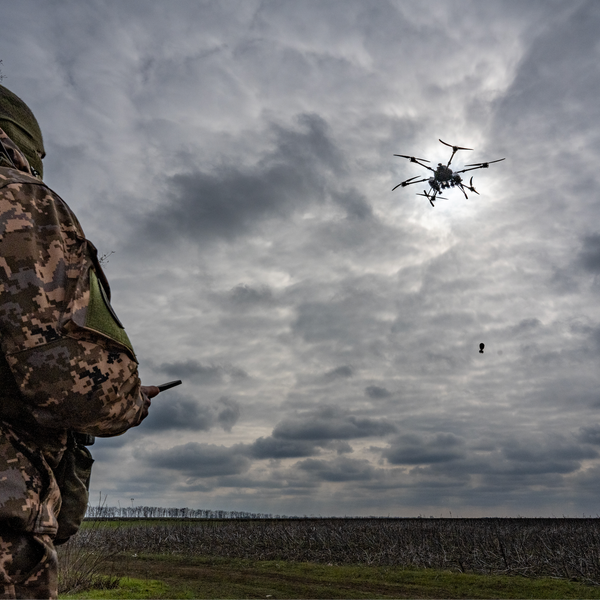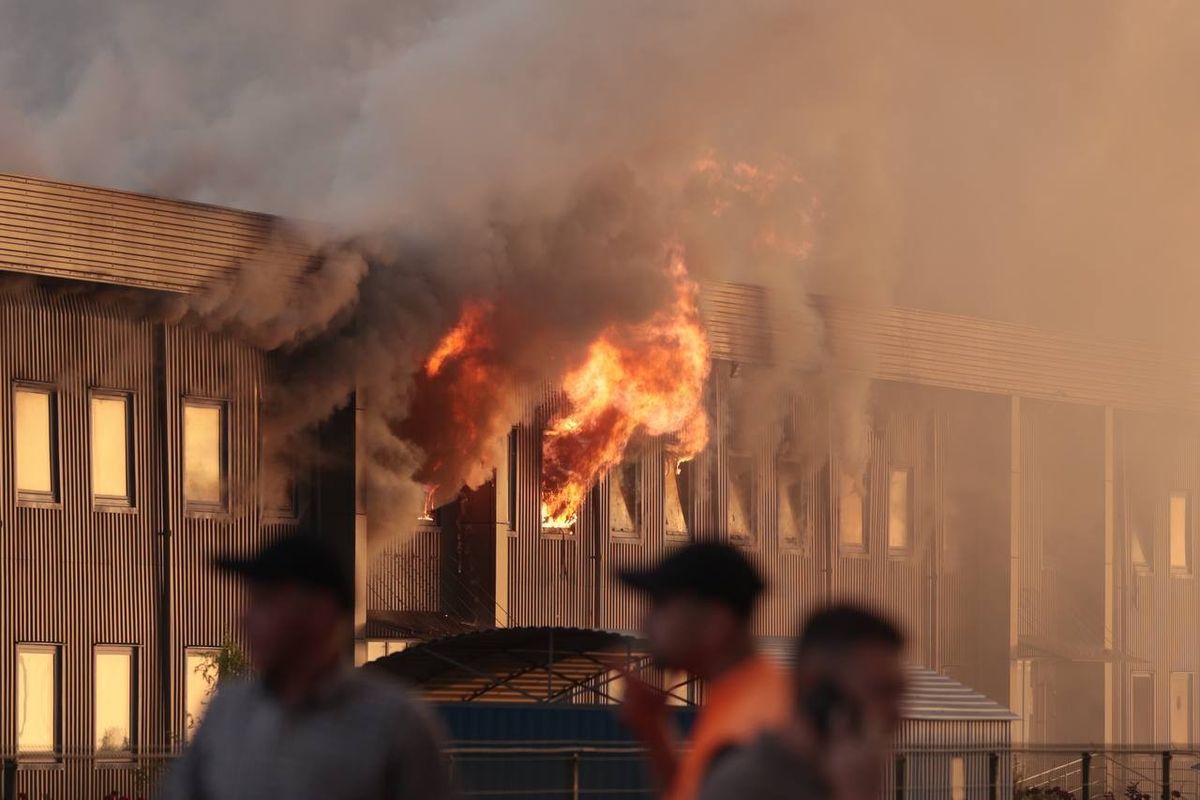OPINION — “We’ve looked extensively at the Ukraine conflict and I can tell you, the use of drones and how we’re seeing drones being utilized in that conflict and other conflicts highlights the need for an integrated approach – netting all your sensors and shooters together so when you’re faced with the appropriate threat you’re able to leverage the appropriate effect, whether it’s a drone, cruise missile or tactical ballistic missile.”
That was Army Major General Sean Gainey, Director, Counter-Unmanned Aircraft Systems, Office of the Army Deputy Chief of Staff for Operations, answering a question about the most important thing learned from fighting in Ukraine and Gaza – a question raised by Rep. John Garamendi (D-Calif.) during last Thursday’s hearing of the House Armed Services Strategic Forces Subcommittee on missile defense.
Answering the same question, Navy Rear Admiral Douglas Williams, Acting Director of the Missile Defense Agency (MDA), said, “The lesson learned with our Israeli allies is it’s critical with the integration of the weapons systems writ large, with the various sub-systems of the Arrow [used against medium-range ballistic missiles], David’s Sling [used against theater ballistic missiles], of Iron Dome [used against lower-tier short-range rockets and projectiles], to integrate effectively in a complete command and control picture so that they can select the optimum missile system to engage the threats that are coming from Gaza from rockets, or from the Houthis originating out of Yemen with ballistic missiles.”
Without much publicity, there has been continuous modernization of the U.S. integrated missile defense systems, from worldwide sensors that detect missile launches all the way to shooters who aim to take them down. That progress seemed to me, among the most interesting and important elements that came up during last week’s House subcommittee hearing, although much of the information about integrated missile defense was disclosed in prepared statements submitted by the participants for the subcommittee record.
For example, MDA Director Williams in his prepared statement said, “the Command and Control, Battle Management and Communication (C2BMC) system operates in a joint, multi-domain environment and connects ground, air, sea, and space sensors and shooters.”
Williams said, “This globally deployed system interfaces with joint, Army, Navy, Air Force, Space Force, NATO and international commands and provides continuous, real-time Missile Defense Command and Control, and Battle Management operations to six [U.S.] Combatant Commands. It also integrates U.S. and coalition operations with allies and partners.”
In addition, this C2BMC program, Williams said, “enables the U.S. President, Secretary of Defense, and Combatant Commanders at strategic, regional and operational levels to systematically plan missile defense operations, collectively see the battle develop, and dynamically manage networked sensors and weapons systems to achieve global and regional mission objectives…The Warfighter also uses this system to understand what is happening in real time in current conflict zones, such as Ukraine and the Middle East.”
Think about that for a minute. President Biden and White House aides could, if they wish, plug in to and follow, active missile defense activities taking place anywhere in the world if U.S. elements are involved.
It's not just for the President anymore. Cipher Brief Subscriber+Members have access to their own Open Source Daily Brief, keeping you up to date on global events impacting national security. It pays to be a Subscriber+Member.
Reading about C2BMC gave me two thoughts: “Engage-on-Remote,” which is the use of data from other sensors to engage or see a threat; and “Launch-on-Remote,” the use of data from other sensors to launch interceptors. Together, these two can provide a seven-fold increase in defended area coverage when compared to one individual weapon system’s organic capability.
Prime Contractor Lockheed Martin says, “C2BMC links the multitude of terrestrial, space and sea-based missile sensors and weapons systems into an integrated system-of-systems to provide a common view of potential or current threats across the globe.” With C2BMC, “weapons systems are able to engage and intercept missiles leveraging launch-on-remote sensor data capability, which significantly increases the defended area that the weapon system can negate the missile threat”.
The fiscal 2024 Missile Defense Agency budget document says C2BMC provides “the capability for persistent acquisition, tracking, cueing, discrimination, and distribution of fire-control quality data to a variety of U.S. missile defense systems.”
Put simply, networked forward-based sensors enable C2BMC to pair the best sensor coverage with the best available weapon system to provide the most effective defense against missile threats.
So, where are the forward-based U.S. sensors?
One set of sensors are giant, early warning radars dating back to the Cold War, the modernized, phased-array radars at Thule Air Base, Greenland; Beale Air Force Base, Calif.; Cape Cod Space Force Station, Mass., and Royal Air Force Fylingdales, United Kingdom; and the Cobra Dane radar at Eareckson Air Station, Alaska.
The Navy has globally deployed its ship-based Aegis anti-missile system against short, medium, and intermediate-range missile threats – originally to protect a ship or convoy, but now has linked it to the worldwide C2BMC system.
The Aegis system, on both cruisers and destroyers, has the AN/SPY-1, advanced, multi-function phased-array radar that is able to perform search, track, and its own interceptor missile guidance functions simultaneously. It also has upgraded its Vertical Launching System and the Standard Missile surface-to-air interceptor missiles it fires.
The Aegis-equipped warships can work together, as well as with C2BMC, to relay tracking and targeting information while attempting to intercept incoming targets.
There are currently 49 Aegis missile defense-capable ships available for worldwide use plus Navy-operated Aegis Ashore sites at land bases in Romania and Poland. By the end of FY 2025, plans are to increase capacity to 56 ships and by FY 2030, the goal is 69 Aegis-fitted ships.
The Ground Based Midcourse Defense system against ballistic missiles is designed to defend the U.S. homeland against intercontinental ballistic missile threats from North Korea and Iran, should it develop an ICBM capability. The system is deployed at military bases in Alaska and California with 44 interceptors and sensors spanning 15 time zones on land, at sea, and in orbit. It is operated from Schriever Space Force Base, Colorado, with five crews at Fort Greely, Alaska and personnel at Vandenberg Space Force Base, California.
Cipher Brief Subscriber+Members enjoy unlimited access to Cipher Brief content, including analysis with experts, private virtual briefings with experts, the M-F Open Source Report and the weekly Dead Drop - an insider look at the latest gossip in the national security space. It pays to be a Subscriber+Member.
The Army’s Terminal High Altitude Area Defense (THAAD) is a transportable system that intercepts ballistic missiles during their final, or terminal, phase of flight. It incorporates an AN/TPY-2 X-band radar, and a single-stage, hit-to-kill interceptor to defeat ballistic missiles inside or outside the atmosphere. The THAAD system defends targets at ranges of 90-to-120 miles. Army force structure for THAAD is currently set at seven batteries, each with six launchers operated by 95 Soldiers.
Currently, one THAAD battery is forward deployed with U.S. Forces in Korea, and one is forward deployed in Guam. The Guam Defense System integrates other existing Defense Department systems, such as Aegis, and calls for a persistent 360-degree Integrated Air/Missile Defense with programs in development distributed across the island under a single command and control facility and organization.
The U.S. has in the past, deployed THAAD units to Guam, Israel, South Korea and Japan. In 2017, Saudi Arabia agreed to buy THAAD in a deal thought to be worth nearly $15 billion. The United Arab Emirates was the first foreign customer for the system and trained its first units in 2015 and 2016. The Pentagon announced in October, that a THAAD system was being sent to the Middle East in response to recent attacks on U.S. troops in the region.
The Patriot is the Army’s most advanced air/missile defense system, capable of intercepting cruise missiles, ballistic missiles and aircraft. The Army has 16 Patriot battalions which are said to operate 50 batteries, which have more than 1,200 missile interceptors.
A Patriot battery normally has 90 soldiers, but only three in a command post are required to operate the battery in combat. A battery includes a command post, radar, eight launchers and support vehicles. Launchers can be located up to a half mile from radar or command post vehicles. In order to establish effective and overlapping defenses, batteries are located 18 to 24 miles between each other.
Once the Patriot interceptor missile is launched, its phased array radar tracks it. As the interceptor approaches, its active seeker will steer it to the target. Older Patriot interceptors will detonate near the threat missile whereas newer ones will seek to impact the threat ballistic missile warhead.
The Patriot’s radar can track up to 100 targets and provide missile guidance data for up to nine missiles. A Patriot battery’s interceptors can provide area coverage and defense for about 9-to-12 miles, and effectively protect a small military base, but only provide coverage for a segment of a large city.
U.S. Patriot batteries are regularly deployed around the world. At last week’s subcommittee hearing, Army Major General Gainey said, “A significant number of Patriot deployments were extended at least once, creating hardships and a lack of predictability for units, soldiers, and families.” Budget documents show that for more than a decade, Patriot personnel deployment times have sometimes gone above the traditional six-to-nine-month rotations.
Patriot systems are operated or being purchased by the Netherlands, Germany, Japan, Israel, Saudi Arabia, Kuwait, Taiwan, Greece, Spain, South Korea, the United Arab Emirates, Qatar, Romania, Sweden, Poland and Bahrain.
The future is represented by the Hypersonic and Ballistic Tracking Space Sensor (HBTSS) program which was described at last week’s subcommittee hearing by Acting Missile Defense Agency Director Rear Admiral Williams who said, “HBTSS will track maneuvering threats that can otherwise evade terrestrial [land-based] radars.” It will have an Overhead Persistent Radar sensor, he said, that will provide “fire-control quality that will enable the engagement and defeat of advanced missile threats.”
“Early next year,” Williams said, “HBTSS will launch and begin demonstration of unique tracking and targeting capabilities needed to defend against hypersonic glide vehicles, followed by two years of on-orbit testing.”
Another subcommittee witness, John Hill, Deputy Assistant Secretary of Defense for Space and Missile Defense Policy, described an ambitious “space-based missile warning, tracking, and detection development roadmap to further enhance the ballistic missile defense overhead persistent infrared capabilities…by fiscal year 2031.”
It will involve the launching of approximately 197 low-Earth orbit satellites and 36 medium-Earth orbit satellites by 2031; two Next-Generation Geosynchronous Earth Orbit satellites by 2027 and two Next-Generation Polar satellites by 2031.
As with much of future air and missile defense, the eyes will be in the sky. Or more likely, in space.
The Cipher Brief is committed to publishing a range of perspectives on national security issues submitted by deeply experienced national security professionals.
Opinions expressed are those of the author and do not represent the views or opinions of The Cipher Brief.
Have a perspective to share based on your experience in the national security field? Send it to Editor@thecipherbrief.com for publication consideration.
Read more expert-driven national security insights, perspective and analysis in The Cipher Brief










